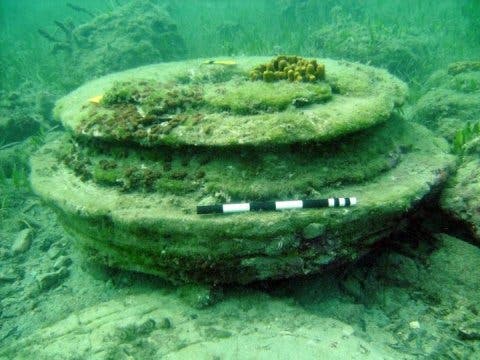Excitement of an underwater “lost city” turned out to be premature, after further research showed the entire structure was actually a natural geological structure formed a few million years ago.

When scores of divers reported what seemed to be an ancient sunken city, archaeologists were thrilled. The divers claimed they saw be paved floors, courtyards and colonnades – all on the shores of the popular tourist island of Zakynthos.
But a research published today proves that the site is nothing like a city – in fact, it’s a geological formation from the Pliocene. Lead author Prof Julian Andrews, from the University of East Anglia’s School of Environmental Sciences, said that the area looks nothing like an archaeological site:
“The site was discovered by snorkelers and first thought to be an ancient city port, lost to the sea. There were what superficially looked like circular column bases, and paved floors. But mysteriously no other signs of life — such as pottery.”
After the initial reports, a research team was quickly assembled. Archaeologist Magda Athanasoula and diver Petros Tsampourakis studied the site, together with Prof Michael Stamatakis from the Department of Geology and Geoenvironment at the University of Athens (UoA). They not only dived to the site, but also studied the texture of the underwater formation with microscopy, X-rays and dated it with isotope techniques. As it turns out, nothing there is man-made and the structures are actually a natural occurrence formed around hydrocarbon seeps. Prof Andrews said:
“We investigated the site, which is between two and five meters under water, and found that it is actually a natural geologically occurring phenomenon. The disk and doughnut morphology, which looked a bit like circular column bases, is typical of mineralization at hydrocarbon seeps — seen both in modern seafloor and palaeo settings.”
Geologically, a fault emerged in the area, allowing hydrocarbons (which are lighter than water) to flow upwards. For scores of microbes, these hydrocarbons are a fantastic source of nutrients – especially methane. The microbe colonies then secrete limestone-like minerals, resulting in the concretionary structures observed here:
“In this case the cement was an unusual mineral called dolomite which rarely forms in seawater, but can be quite common in microbe-rich sediments,” Andrews added. “These concretions were then exhumed by erosion to be exposed on the seabed today. This kind of phenomenon is quite rare in shallow waters. Most similar discoveries tend to be many hundreds and often thousands of meters deep underwater.”
Journal Reference: Exhumed hydrocarbon-seep authigenic carbonates from Zakynthos Island (Greece): Concretions not archaeological remains. Marine and Petroleum Geology, 2016; 76: 16 DOI:10.1016/j.marpetgeo.2016.05.022






